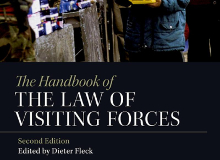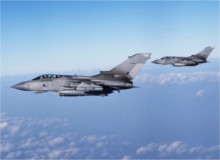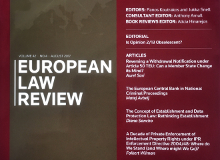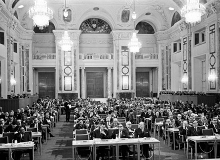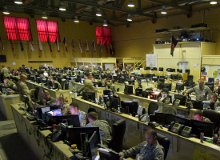Introduction
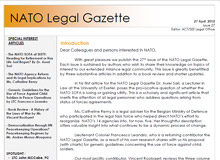
On 4 March 2005, US troops shot and killed Nicola Calipari, an Italian military intelligence officer, at a roadblock in Iraq. Earlier that day, Calipari and a fellow officer had recovered an Italian hostage from her kidnappers in downtown Baghdad. On their way back to Baghdad International Airport, their car approached a blocking position manned by US forces and came under fire. All three occupants of the car were wounded, while Calipari suffered fatal injuries and died at the scene. A joint US-Italian investigation launched into the incident failed to arrive at shared final conclusions. Whereas the US military determined that the troops involved acted in accordance with the applicable rules of engagement and therefore bore no responsibility for any wrongdoing, the Italian investigators concluded that the shooting occurred as a result of a series of mistakes, including what they considered to be the misguided placement of the blocking position. Proceedings were subsequently instituted against the US soldier responsible for firing the shots, Specialist Mario Lozano, to be tried in absentia for murder and attempted murder in Rome.
The facts of this case presented the Italian courts with something of a dilemma, for the proceedings concerned a situation where one sending State, Italy, sought to exercise its criminal jurisdiction over a member of the armed forces belonging to another sending State, the United States, for acts committed by the latter against its personnel and nationals in the territory of a third State, namely Iraq. Considering that the majority of jurisdictional conflicts involving foreign forces arise between sending States and receiving States, the Lozano case presented a somewhat unusual set of circumstances which prompted the Italian courts to base their decisions on the applicable rules of customary international law. In its judgment delivered in October 2007, the Court of Assizes of Rome dismissed the case at first instance, holding that the jurisdiction enjoyed by the United States pursuant to the principle of the ‘law of the flag’ (principio del diritto di bandiera) prevailed over the passive jurisdiction claimed by Italy.1 This ruling was affirmed by the Court of Cassation in July 2008, but on very different grounds.2 According to the Court of Cassation, the evolution of international practice since the end of the Second World War has led to the progressive limitation of the principle of the law of the flag: current international law consequently gives effect to the territorial jurisdiction of the receiving State alongside the principle of the law of the flag, as evidenced by the arrangements governing the exercise of criminal jurisdiction under Article VII of the NATO SOFA of 1951. While the Court of Cassation therefore rejected the idea that the United States benefited from primary jurisdiction pursuant to the law of the flag, it held that Lozano was nevertheless exempt from the Italian criminal process under the more general principle of functional immunity ratione materiae.
These judgments raise some fascinating questions, including whether or not the two courts should have recognized the exclusive nature of US jurisdiction on the basis of the combined effect of CPA Order No 17 of 27 June 2004 and Security Council Resolution 1546 of 8 June 2004. The decision of the Court of Cassation also raises a more general question about the evolution of the rules of international law governing the status of foreign military deployments. The picture painted by the Court of Cassation is one of seamless continuity, where the traditional principle of the law of the flag was gradually infused with greater respect for territorial sovereignty during the course of the twentieth century, eventually to be supplanted by the more progressive principle of concurrent jurisdiction as manifested in the NATO SOFA. This story of course closely echoes the evolution of the law of State immunity from an absolute doctrine of immunity to a more restrictive theory. Attractive though it sounds, the storyline is a false one. This short contribution aims to add a bit more colour to the portrait painted by the Court of Cassation and pinpoint the proper place of the NATO SOFA within it.
No Uniform Regime
It is tempting to search for common principles in order to make sense of the maze of different legal instruments and regimes that govern the status of foreign armed forces under international law. While there can be little doubt that international practice does rest on certain universal principles, such as the principle of functional immunity, a closer reading suggests that despite a high degree of consistency, international practice is not uniform. In particular, as I have argued elsewhere,3 no universal treaty regime has emerged in international practice. This is so for three main reasons. First, States send members of their armed forces abroad for a wide variety of reasons, for instance to participate in joint exercises, to provide technical assistance or to contribute to peace support operations. Legal arrangements appropriate for one kind of mission may not be suitable for other types of deployments. Second, the operational circumstances of foreign military deployments may differ drastically from one case to another and raise different security considerations. This needs to be reflected in the applicable status arrangements. Finally, status of forces agreements are the product of political bargaining. More influential States are sometimes capable of securing for themselves conditions of stay which are more favourable than those they would be prepared to grant to foreign forces present within their own territory. The combined effect of the diverse objectives pursued by foreign military deployments, their different operational environments as well as the political disparities between sending States and receiving States means that status of forces agreements differ widely in their terms. No single treaty regime has consequently emerged to govern the status of all foreign military deployments in a universal manner.
Despite this lack of uniformity, there is nonetheless a considerable degree of consistency in international practice. By entering into similar status arrangements under similar circumstances on successive occasions, States and international organizations have built up a substantial body of practice relating to certain types of military deployments. For present purposes, three groups of agreements may be distinguishes in this respect. First, status of forces agreements concluded in the context of structured military cooperation between politically equal partners have frequently been based on the NATO SOFA of 1951.4 The Member States of the EU have thus modelled the EU SOFA of 2003,5 which governs the legal position of their military and civilian staff deployed within the territory of the EU for the purposes of European security and defence cooperation, on the relevant provisions of the NATO SOFA. Second, the UN and other international actors have developed distinct arrangements regulating the privileges and immunities of peace support operations, which for the most part reflect the terms of the UN Model SOFA of 1990.6 Finally, the third group includes all other legal arrangements, such as agreements conferring broader rights of exclusive jurisdiction outside the context of peace operations,7 instruments relying on the provisions of the Vienna Convention on Diplomatic Relations8 and agreements which for one reason or another are atypical.9
Generally speaking, these different types of agreements offer different answers to the same basic question: how to reconcile the divergent legal interests of sending States and receiving States, in particular as regards the exercise of jurisdiction over military personnel present abroad. The fact that different categories of status of forces agreements can be distinguished along these lines suggests two points. International practice relating to status of forces agreements has not followed a linear path of development as the Court of Cassation suggested in the Lozano case, but is more nuanced. This in turn implies that the NATO SOFA does not represent the evolutionary pinnacle of the law of visiting forces, but serves as an appropriate precedent in more limited circumstances only.
What’s So Special About the NATO SOFA?
Status of forces agreements are not a recent invention: they have existed as formal instruments of international law for at least two hundred years.10 Whereas status agreements initially operated on a strictly bilateral level, the onset of the Cold War in the late 1940s created an entirely new set of circumstances calling for the conclusion of the first multilateral agreements: for the first time ever, friendly armed forces were stationed abroad in large numbers on a semi-permanent basis for the purposes of collective security and self-defence in times of peace. The first multilateral agreement drawn up to reflect these novel circumstances was the Brussels Treaty SOFA, adopted on 21 December 1949.11
The Brussels Treaty SOFA was designed to define the legal status of forces operating in the context of the Brussels Treaty for collective self-defence concluded between Belgium, France, Luxembourg, the Netherlands and the United Kingdom in 1948,12 in particular the military personnel stationed at the joint military headquarters at Fontainebleau in France.13 It was agreed at the very beginning of the drafting process that the aim of the negotiations was to arrive at ‘a general agreement between the Five Powers on a basis of complete reciprocity’.14 Although the final text leaned heavily on earlier bilateral practice, the significance of the Brussels Treaty SOFA lay in the fact that it adapted these bilateral arrangements for a multilateral setting, in particular by laying down rules governing the exercise of jurisdiction over foreign personnel which were designed to balance the competing legal interests of sending States and receiving States in an equitable manner and on the basis of complete reciprocity. The Brussels Treaty SOFA thus set up a system of concurrent jurisdiction under which conflicts of competence in criminal matters were to be resolved primarily by administrative action, while civil claims against foreign forces were to be settled by the receiving State on the basis of its own laws, with the costs of satisfying these claims to be distributed between the States Parties.
Although the Brussels Treaty SOFA lost its political significance following the conclusion of the North Atlantic Treaty and never entered into force, it shaped modern legal practice by serving as a basis for the NATO SOFA.15 Indeed, the travaux préparatoires of the NATO SOFA suggests that the existence of the Brussels Treaty SOFA played a rather important role in facilitating early agreement on its jurisdictional provisions. In particular, by upholding the principle of concurrent jurisdiction underlying the Brussels Treaty SOFA, but at the same time enabling sending States to exercise their jurisdiction in those types of cases where their interests were most directly affected,16 the drafters of the NATO SOFA were able to devise a more flexible system for the allocation of the right to exercise jurisdiction ‘which each side could accept as being equitable’ and which subsequently became Article VII of the NATO SOFA.17 Whereas the transition from bilateral to multilateral status of forces agreements thus began with the Brussels Treaty SOFA, it was the conclusion of the NATO SOFA in June 1951 which put the principle of complete reciprocity into practice and thereby laid the foundations for the multilateral period of foreign military deployments.
But is it Custom?
Unlike the Brussels Treaty SOFA, the NATO SOFA has not only generated a vast amount of practice among its signatories, but it has also served as a model for a large number of other bilateral and multilateral status of forces agreements. Two factors played a key role in this regard. The fact that the United States, by far the most prolific sending State within the Alliance, became a Contracting Party ensured that the NATO SOFA had a much broader impact than the Brussels Treaty SOFA was ever likely to achieve. Even more importantly, the jurisdictional provisions of the NATO SOFA were widely perceived to have struck a fair balance between the interests of sending States and receiving States, and for this reason have attained a high degree of legitimacy even among States not parties to the Agreement.
The NATO SOFA’s substantial impact on international cooperation raises the question of whether or not it reflects customary international law. While there can be little doubt that its individual terms did not codify pre-existing rules of customary international law at the time of their adoption in 1951, it is equally obvious that they gave effect to certain general principles of international law, such as the principle of State sovereignty and State responsibility, and of course continue to do so. The more relevant question, therefore, is whether any specific provisions of the NATO SOFA have attained the status of rules of customary international law since 1951 as a result of subsequent practice. Considering the very large number of agreements which replicate or otherwise reproduce the jurisdictional arrangements laid down in the NATO SOFA, there exists a considerable body of State practice to support the argument that at least certain provisions of the NATO SOFA may have passed into custom. Nevertheless, this argument encounters some practical and conceptual difficulties.18
First, whilst the volume and consistency of pertinent State practice may be sufficient to count towards the development of rules of customary international law, proving the existence of corresponding opinio juris is rather more difficult, at least if one takes their opinio juris seriously. Second, the existence of several distinct legal regimes governing the status of different types of foreign forces demonstrates that, contrary to the Court of Cassation’s pronouncement in Lozano, the provisions of the NATO SOFA could not have evolved into rules of customary international law applicable to all foreign military deployments.19 If certain parts of the NATO SOFA have passed into custom, they did so only with respect to deployments comparable to those for which the NATO SOFA was designed, namely the deployment of armed forces in the territory of politically equal partners in the context of structured military cooperation. The necessarily imprecise nature of this caveat means that the field of application of any rules of customary international law arising from the NATO SOFA cannot be stated with absolute precision. Third, the NATO SOFA has stood as a beacon of legal reciprocity in relations between sending States and receiving States since 1951.20 In the case of the NATO SOFA, legal reciprocity came about as a consequence of the political equality among its signatories. However, States finding themselves in fundamentally different political circumstances may still demand to benefit from the principle of complete reciprocity and insist on the application of rules derived from the NATO SOFA in an attempt to achieve political parity. Here, legal reciprocity becomes a means to political equality. As a matter of strict law, nothing precludes States from pursuing such a policy, since as jus dispositivum, any rules of customary international law which may have arisen from the NATO SOFA may be displaced between the parties of an international agreement to this effect. In other words, even if under customary international law the principle of complete reciprocity only ought to be applied in operational conditions comparable to those of the NATO SOFA, the existence of such customary rules could not prevent, to use a random example, the interim government of a post-conflict country from seeking to subject a multinational peace operation present within its territory to the terms of the NATO SOFA.
None of this is to say that the question of whether the NATO SOFA forms part of customary international law admits of no answer or is of no significance. On the contrary: understanding the NATO SOFA’s contribution to the development of customary international law is not only critical to a better understanding of the general principles that govern the legal status of foreign military deployments under all circumstances, but it also provides a basis for questioning the legitimacy of attempts to extend the principle of complete reciprocity to entirely different operational circumstances.
Conclusion
For over six decades now, the NATO SOFA has served as an effective legal framework for the deployment of large numbers of military forces and associated personnel without a single amendment to its terms. Even cautious observers would describe this as a major achievement. What, then, accounts for this success? The recipe seems to be simple enough: focus on getting the basic principles right and leave most of the details to be worked out later in supplementing agreements. While the continued health of the NATO SOFA depends on the vitality of the North Atlantic Treaty, its impact and legacy extends far beyond the Alliance. Whether or not the NATO SOFA is headed for retirement or remains in force for another sixty years, it has attained such a degree of international recognition and legitimacy which would seem to guarantee its continued influence on international practice for the foreseeable future.
Published in the NATO Legal Gazette (April 2012), Issue 27, 2–8
1Judgment No 07/21, Italy v. Mario Luiz Lozano, 14 October 2007 (Corte di Assise di Roma) (on file with the author).
2Judgment No 31171/2008, Italy v. Mario Luiz Lozano, 24 July 2008 (Corte Suprema di Cassazione), Oxford Reports on International Law in Domestic Courts 1085 (IT 2008).
3A. Sari, ‘Status of Forces and Status of Mission Agreements under the ESDP: The EU’s Evolving Practice’, (2008) 19 EJIL 67, at 69.
4Agreement between the Parties to the North Atlantic Treaty Regarding the Status of Their Forces, 19 June 1951, 199 UNTS 67.
6UN doc. A/45/594, Model status-of-forces agreement for peace-keeping operations: Report of the Secretary-General, 9 October 1990.
7E.g. Vereinbarung zwischen der Regierung der Bundesrepublik Deutschland und der Regierung der Vereinigten Republik Tansania über die Rechtsstellung der an der Übung ‘TANZANITE 2002’ beteiligten Streitkräfte der Bundeswehr in der Vereinigten Republik Tansania, 22 January 2002, BGBl (2002) II 621.
8E.g Agreement regarding the Status of United States Military and Civilian Personnel of the United States Department of Defense Who may be present in Rwanda in Connection with the Military Airlift of Rwandan Military Forces in Support of Operations in Darfur and Future Mutually Agreed Activities, 11 July 2005, KAV 7344.
9Cf. Convention relating to the Conditions for French Technical Military Assistance in the Training, Organization and Equipment of the Comorian Forces and the Training of Comorian Soldiers at Military Schools and Instruction Centres in France, 4 August 1979, 1309 UNTS 178.
10See, for example, the Convention between Prussia and Russia for the Passage of Troops, 28 May 1815, 64 CTS 363.
11Agreement Relative to the Status of Members of the Armed Forces of the Brussels Treaty Powers, 21 December 1949, (1950) Cmd. 7868.
12Treaty for Collaboration in Economic, Social and Cultural Matters and for Collective Self-defence, 17 March 1948, 19 UNTS 53.
13Minutes of the 47th Meeting of the Permanent Commission, 7 January 1949, DG/1/13/65, at 3. On file with the author.
14Report from the Military Committee, 15 June 1949, DG/1/13/65, at 19 (emphasis added). On file with the author.
15D–D(51) 23, 23 January 1951, in J. M. Snee, NATO Agreements on Status: Travaux Préparatoires (1966).
16MS(J)–R(51) 2, 8 February 1951, in ibid., at paras. 14–17.
17D–R(51) 15, 2 March 1951, in ibid.
18See also M. S. Johnson, ‘NATO SOFA: Enunciating Customary International Law or Just a Model, and What Does the Future Portend?’, in H. Fischer et al. (eds), Krisensicherung und Humanitärer Schutz – Crisis Management and Humanitarian Protection: Festschrift für Dieter Fleck (2004) 287, esp. at 290–292.
19To similar effect, see D. Fleck, ‘Introduction’, in D. Fleck (ed.) The Handbook of the Law of Visiting Forces (2001) 3, at 5–7.
20This sometimes lead to agreements based on different principles to be revised and brought in line with the NATO SOFA, e.g. R. A. Porrata-Doria, ‘The Philippine Bases and Status of Forces Agreement: Lessons for the Future’, (1992) 137 Military Law Review 67, at 70–81.


